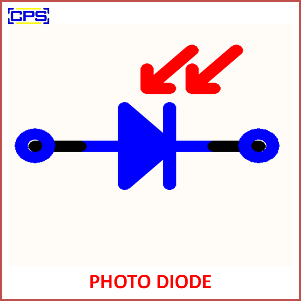A Photodiode is a semiconductor device that converts light into an electrical current. It is a type of diode specifically designed to operate in reverse bias, where the current produced is proportional to the intensity of the light incident on its surface.

Key Features of a Photodiode
- Light Sensitivity:
- Converts light (photons) into an electrical signal (photoelectric effect).
- Operation Mode:
- Operates primarily in reverse bias, where a small reverse current flows in response to light.
- Material:
- Made from materials like silicon (Si), gallium arsenide (GaAs), or indium gallium arsenide (InGaAs), depending on the wavelength of light to be detected.
Working Principle:
- When light hits the photodiode, photons are absorbed in the depletion region of the junction, creating electron-hole pairs.
- These charge carriers are separated by the electric field of the junction, generating a photocurrent proportional to the light intensity.
Types of Photodiodes:
- PN Junction Photodiode:
- Basic structure; used for general applications.
- PIN Photodiode:
- Includes an intrinsic layer between P and N regions for higher sensitivity and faster response.
- Avalanche Photodiode:
- Uses high reverse bias to amplify the signal for detecting very low light levels.
- Schottky Photodiode:
- Uses a metal-semiconductor junction for fast response in specific applications.
Applications of Photodiodes:
- Light Detection:
- Used in light meters, optical sensors, and laser receivers.
- Communication:
- Key component in fiber-optic communication systems.
- Medical Devices:
- Used in pulse oximeters and other diagnostic equipment.
- Safety Systems:
- Incorporated in smoke detectors, burglar alarms, and motion sensors.
- Industrial Automation:
- Employed in barcode scanners, object detection, and quality control systems.
Advantages:
- High sensitivity to light.
- Fast response time.
- Wide spectral response range.
Disadvantages:
- Susceptible to noise from ambient light.
- Performance varies with temperature changes.
- Limited output current in low-light conditions.
